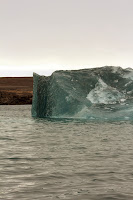EARLY last century the Canadian
government was keen to show the world that this collection of islands inside
the Arctic Circle was part of its territory so it sent Royal Canadian Mounted
Police to staff isolated stations along the Northwest Passage.
Just one of these remote posts
was in a little place called Dundas Harbour, a night's sail from Pond Inlet on
the shore of Devon Island, and two men were based here every year from the
early 1920s until the late 1950s.
There wasn't much for them to do –
no hunting licences to issue, no traffic stops to make, and certainly no
domestic disputes to mediate – but huddle against the sub-zero temperatures
during the long months when the sun never rose above Devon Island.
Sometimes families would
accompany these men to the post, but more often than not the only company the
policemen would have for months at a time were the Inuit guides responsible for
keeping them alive during winter.
The RCMP camp closed in the
1950s, when Canada was happy the world knew this land was part of its sovereign
territory, and the destination because part of Arctic folklore with many of the
locals up this way related to someone who once lived at Dundas Harbour.
Since then Devon Island has been the world's largest uninhabited island.
The passengers aboard the Clipper
Adventurer were lucky enough to visit Dundas Harbour today, and see the shacks
that remain from the days when this place was home to a RCMP camp, but not before our plans were interupted by a single polar bear.
We were going to land on another
beach and walk to the RCMP post but, soon after dropping anchor, our guides
discovered the polar bear camped on the weather-beaten peninsula so that plan was scrapped and
it was into the zodiacs for some waterborne exploration.
The beast was looking for a feed,
staying close to a family of walrus occupying a rock at one end of the beach,
and our driver Chris was able to get the zodiac close enough to snap some
pictures of this great white creature before motoring on to the marine mammals.
He told us the bear was a teenage
lad, not afraid of anything, and the creature spent as much time looking at us
as we did looking at him and even sat down on his considerable rump a few times
to relax while taking in the view.
We caught a glimpse of the walrus
as we rounded the point, but he was wrapped in a ball sleeping, with brown skin
camouflaged by the brown rock, so we didn't get a very good view.
Chris decided not to get
close to close to this big bloke, who seemed happy to spend the morning snoozing now some nice people had scared the hunting bear away with a fleet of buzzing zodiacs, because his relatives were in the water and we didn't want to cause a stir.
There were a couple of wooden
buildings in the sand by the beach, battered by the Arctic gales and bleached
by the strong sun that beats down when the clouds do part, and an outhouse a
little further along the beach.
From our vantage point just
offshore we could also see the white picket fence guarding the cemetery set
further up the hill towards the rocky peak that loomed over the antique
settlement.
Cruise historian Ken McGoogan told us only two people were resting in the graveyard, both RCMP members posted to the Dundas Harbor camp early last century.
The Northwest Passage expert explained that one of them men shot himself when the isolation of the Dundas Harbour post became too much while the other perished in a "hunting accident".
Our zodiac was last back to the
ship, which meant we had to hover until the other boatload’s of passengers
could be offloaded and the boat hauled onto the deck, so Chris took the long
was home and we did a lap of the iceberg resting nearby.
Chris explained it was a perfect
specimen of an iceberg that had broken away from a glacier and travelled a fair
distance and he noted that the lack of air bubbles beneath the surface
indicated it was a solid piece for frozen water.
From our vantage point at sea
level the iceberg looked like a pervious stone, or at least a chunk of crystal,
with various shades of blue coming together to reveal creases and cracks in the
frozen surface.



























